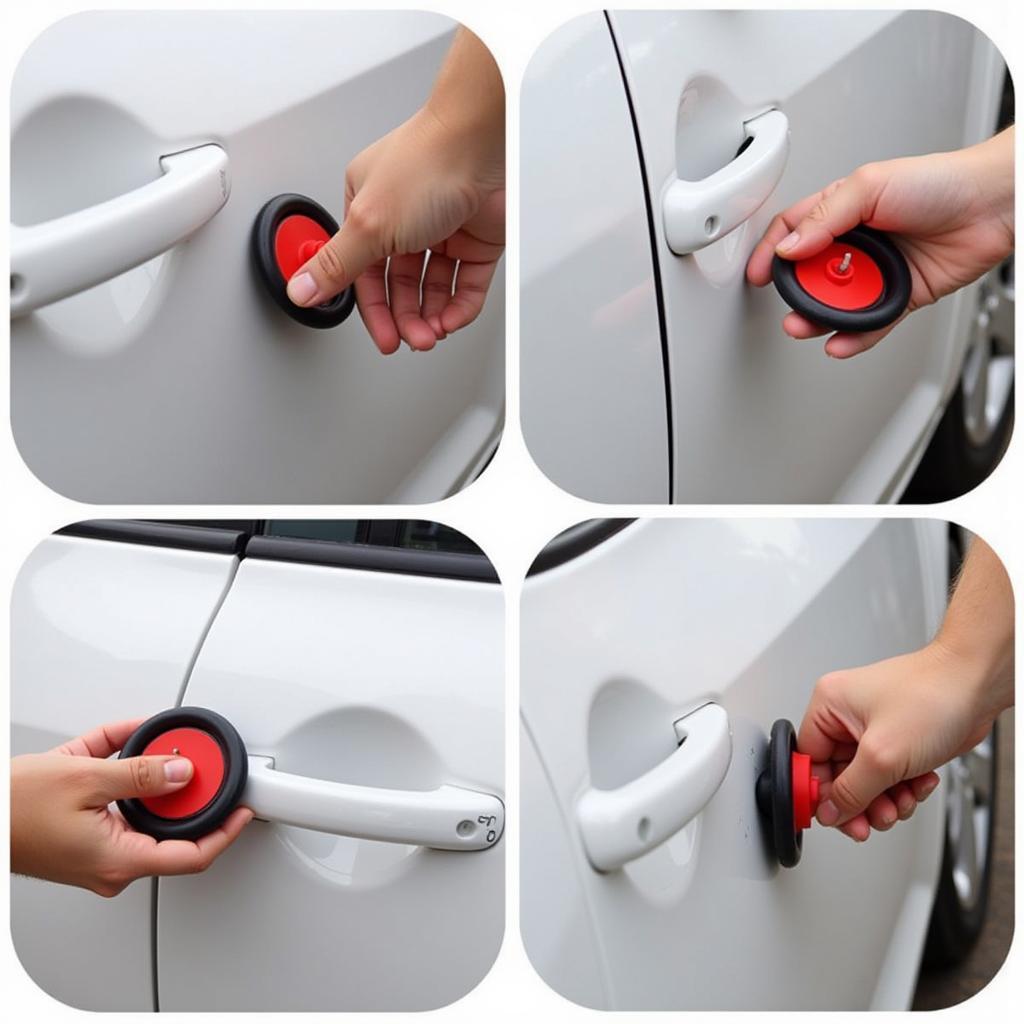Fixing car dents yourself can be a cost-effective and satisfying experience. This guide will walk you through the process, from assessing the damage to achieving a professional-looking repair without breaking the bank. We’ll cover various techniques, tools, and tips to help you tackle those unsightly dents and restore your car’s appearance.
 Fixing Minor Car Dents with a Plunger
Fixing Minor Car Dents with a Plunger
Before you begin, assess the dent. Is it a shallow ding or a deep crease? Is the paint chipped or scratched? Knowing the extent of the damage will help you choose the right repair method. For minor dents, a simple DIY fix might be all you need. However, more significant damage may require professional intervention. This article focuses on those manageable dents that you can Fix Car Dents Yourself. Soon after reading this, you may be able to confidently handle fixing scratches on new car.
Understanding Different Dent Types
Small Dents and Dings
Small dents, often caused by minor impacts like shopping carts or hail, can often be addressed with paintless dent repair (PDR) techniques. These methods involve manipulating the metal back into its original shape without affecting the paint.
Sharp Creases and Deep Dents
Deeper dents or those with sharp creases may require more advanced techniques like filling and sanding. These are often accompanied by paint damage and require more skill and patience.
How to Fix Car Dents Yourself: DIY Methods
Using a Plunger
For small, shallow dents, a simple suction cup plunger can work wonders. Wet the plunger and the dent, then push and pull until the dent pops out. It’s a surprisingly effective method for minor imperfections.
Hot Glue and Pulling Method
This technique involves gluing plastic tabs to the dent and then using a pulling tool to gradually pull the dent out. It requires specialized tools but offers good control for more stubborn dents.
Using a Hair Dryer and Compressed Air
This method utilizes the rapid temperature change to manipulate the metal. Warm the dent with a hair dryer, then quickly spray it with compressed air. The rapid cooling can sometimes cause the dent to pop back out. This method is best suited for plastic bumpers and trims.
Tools and Materials You’ll Need
- Plunger
- Hot glue gun and glue sticks
- Dent pulling kit
- Hair dryer
- Compressed air can
- Body filler (for deeper dents)
- Sandpaper
- Primer
- Paint (if necessary)
Tips for Success
- Clean the area around the dent thoroughly.
- Be patient and work slowly.
- Multiple applications of a technique may be necessary.
- For deeper dents, filling and sanding are often required.
- If you’re uncertain about any step, consult a professional. Don’t hesitate to ask about [car accessories fixing near me](https://autotippro.com/car-accessories-fixing-near me/).
“Patience is key when fixing car dents yourself,” advises John Smith, an automotive repair specialist at Smith Auto Repair. “Don’t expect miracles on the first try. Practice and careful execution will lead to the best results.”
When to Call a Professional
While many dents can be tackled with DIY methods, some situations warrant professional help. Deep dents with significant paint damage, structural damage, or dents in challenging locations are best left to the experts.
“While DIY repairs can be cost-effective, there are limitations,” explains Jane Doe, a certified collision repair technician. “Complex dents or those affecting structural integrity should always be handled by professionals.” You may find these services related to queries such as how to fix car rust damage as well. Additionally, if your car’s USB charging is slow, you may want to explore car usb charging slow fix for practical solutions. For those tricky electrical issues, understanding how to fix cigarette socket in car can be incredibly helpful.
Conclusion
Fixing car dents yourself can be a rewarding endeavor, saving you money and restoring your car’s appearance. By understanding the various techniques and using the right tools, you can successfully tackle many types of dents. However, remember to assess the damage carefully and know when to seek professional assistance. For further assistance, contact AutoTipPro at +1 (641) 206-8880 or visit our office at 500 N St Mary’s St, San Antonio, TX 78205, United States. We’re here to help you get back on the road with a dent-free ride.




Leave a Reply